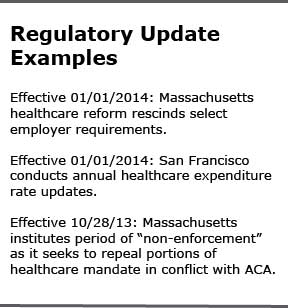It is my pleasure to introduce a guest blogger for this latest post. Jenn Shorr is a contract analyst here at Jacobson, administering contracts and overseeing Jacobson’s risk management program. Her insights into mandated employer benefits are worth a read. Enjoy…
The past five to seven years have seen a marked increase in the number of cities, municipalities and states enacting regulations or legislation that require employers to provide a variety of benefits including: paid or unpaid sick leave, disability coverage, extended FMLA leave, and mandated healthcare assistance. There are currently ten cities, municipalities or states that require employers to provide at least some sort of employee benefit—a number that is set to increase by the end of 2014. While some of these regulations have been impacted by the implementation of the PPACA, the movement towards local mandates has been a familiar employee benefits trend. As the workplace experiences a fundamental shift with traditional employment models being modified to make room for part-time, temporary, and consulting relationships, so too has the concept of benefits eligibility and entitlement.
 If you currently rely on a staffing service provider, you may think these mandates don’t affect you. As the employer of record, the staffing service provider is responsible for all the fees and liabilities; right?
If you currently rely on a staffing service provider, you may think these mandates don’t affect you. As the employer of record, the staffing service provider is responsible for all the fees and liabilities; right?
Not so fast.
Some regulations actually do address temporary employment situations or deem both the staffing provider and the client company as joint employers, even if your agreement says otherwise. As the expert in identifying, retaining and employing talent, your staffing provider should be your compliance partner. They should be aware of the regulations, have compliance and audit processes in place, and clearly spell out your role and participation in the compliance process. Understanding whether your staffing provider has sound compliance processes in place will help you avoid a potentially unknown liability.
At Jacobson, we review every situation with a thorough and strategic approach. We are regularly monitoring reliable resources for regulatory updates; and, when a new requirement is enacted, we go directly to the source and read the actual regulation or legislation. Our HR and compliance team meet with our senior leadership to discuss compliance options, the challenges unique to our industry, and the anticipated financial impact.
The next step is education. We educate staff members on the regulations and compliance process as it applies to their roles. We educate our clients about their participation. We educate our employees about their rights under the new law or regulation. Finally, we audit, monitor and reevaluate. Where are the communication and administration gaps? Have the regulations been updated recently? No matter how minor the change, we are on top of it.
Does your staffing vendor have a process in place for handling changing laws and regulations?